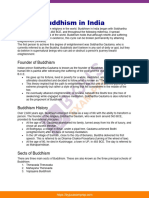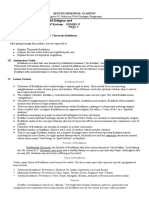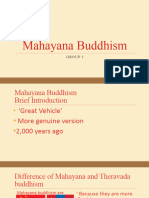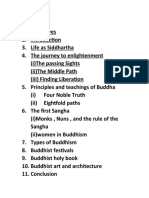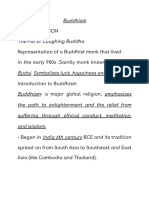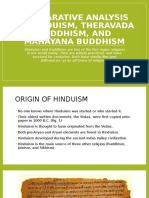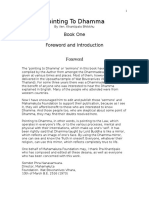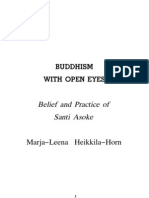100%(1)100% found this document useful (1 vote)
34 viewsBuddhism
Buddhism
Uploaded by
vylelijahmanuel02This document provides an overview of Buddhism, including its history, core teachings, beliefs, and practices. It begins by stating the learning objectives are to examine Buddhism's history, identify its central teachings and beliefs, and analyze related issues. It then discusses Buddhism's founder Siddhartha Gautama and the key events in his life that led to the founding of Buddhism. The document also summarizes Buddhism's main beliefs like the Four Noble Truths and Eightfold Path, different types of Buddhism, important texts, and holidays celebrated by Buddhists. It concludes by briefly discussing selected issues like war and women's roles in Buddhism.
Copyright:
© All Rights Reserved
Available Formats
Download as PPTX, PDF, TXT or read online from Scribd
Buddhism
Buddhism
Uploaded by
vylelijahmanuel02100%(1)100% found this document useful (1 vote)
34 views49 pagesThis document provides an overview of Buddhism, including its history, core teachings, beliefs, and practices. It begins by stating the learning objectives are to examine Buddhism's history, identify its central teachings and beliefs, and analyze related issues. It then discusses Buddhism's founder Siddhartha Gautama and the key events in his life that led to the founding of Buddhism. The document also summarizes Buddhism's main beliefs like the Four Noble Truths and Eightfold Path, different types of Buddhism, important texts, and holidays celebrated by Buddhists. It concludes by briefly discussing selected issues like war and women's roles in Buddhism.
Original Description:
PPT on Buddhism
Original Title
buddhism
Copyright
© © All Rights Reserved
Available Formats
PPTX, PDF, TXT or read online from Scribd
Share this document
Did you find this document useful?
Is this content inappropriate?
This document provides an overview of Buddhism, including its history, core teachings, beliefs, and practices. It begins by stating the learning objectives are to examine Buddhism's history, identify its central teachings and beliefs, and analyze related issues. It then discusses Buddhism's founder Siddhartha Gautama and the key events in his life that led to the founding of Buddhism. The document also summarizes Buddhism's main beliefs like the Four Noble Truths and Eightfold Path, different types of Buddhism, important texts, and holidays celebrated by Buddhists. It concludes by briefly discussing selected issues like war and women's roles in Buddhism.
Copyright:
© All Rights Reserved
Available Formats
Download as PPTX, PDF, TXT or read online from Scribd
Download as pptx, pdf, or txt
100%(1)100% found this document useful (1 vote)
34 views49 pagesBuddhism
Buddhism
Uploaded by
vylelijahmanuel02This document provides an overview of Buddhism, including its history, core teachings, beliefs, and practices. It begins by stating the learning objectives are to examine Buddhism's history, identify its central teachings and beliefs, and analyze related issues. It then discusses Buddhism's founder Siddhartha Gautama and the key events in his life that led to the founding of Buddhism. The document also summarizes Buddhism's main beliefs like the Four Noble Truths and Eightfold Path, different types of Buddhism, important texts, and holidays celebrated by Buddhists. It concludes by briefly discussing selected issues like war and women's roles in Buddhism.
Copyright:
© All Rights Reserved
Available Formats
Download as PPTX, PDF, TXT or read online from Scribd
Download as pptx, pdf, or txt
You are on page 1of 49
LEARNING OBJECTIVES:
At the end of the lesson, the learners are expected to:
1.Examine the history of Buddhism;
2.Identify the core teaching, beliefs, and practices of
Buddhism;
3.Analyze other related issues of Buddhism.
• Buddhism is a faith that was
founded by Siddhartha
Gautama (“the Buddha”) more
than 2,500 years ago in India.
With about 470 million
followers, scholars consider
Buddhism one of the major
world religions. Its practice has
historically been most
prominent in East and
Southeast Asia, but its
influence is growing in the
West. Many Buddhist ideas
and philo sophies overlap
with those of other
FOUNDER OF BUDDHISM
• Siddhartha Gautama, the
founder of Buddhism who
later became known as
“the Buddha,” lived during
the 5th century B.C.
• Gautama was born into a
wealthy family as a prince
in present-day Nepal.
Although he had an easy
life, Gautama was moved
by suffering in the world.
• He decided to give up his lavish
lifestyle and endure poverty. When
this didn’t fulfill him, he promoted
the idea of the “Middle Way,” which
means existing between two
extremes. Thus, he sought a life
without social indulgences but also
without deprivation.
• After six years of searching,
Buddhists believe Gautama found
enlightenment at age 35 while
meditating under a Bodhi tree. He
spent the rest of his life teaching
others about how to achieve
this spiritual state.
Buddhism History
• When Gautama passed away around 483 B.C., his followers
began to organize a religious movement. Buddha’s teachings
became the foundation for what would develop into Buddhism.
• In the 3rd century B.C., Ashoka the Great, the Mauryan Indian
emperor, made Buddhism the state religion of India. Buddhist
monasteries were built, and missionary work was encouraged.
• Over the next few centuries, Buddhism began to spread
beyond India. The thoughts and philosophies of Buddhists
became diverse, with some followers interpreting ideas
differently than others.
• In the sixth century, the Huns invaded India and destroyed
hundreds of Buddhist monasteries, but the intruders
were eventually driven out of the country.
TYPES OF BUDDHISM
• Today, many forms of Buddhism exist around the world. The
three main types that represent specific geographical areas
include:
• Theravada Buddhism: Prevalent in Thailand, Sri Lanka,
Cambodia, Laos and Burma
• Mahayana Buddhism: Prevalent in China, Japan, Taiwan,
Korea, Singapore and Vietnam
• Each of these types reveres certain texts and has slightly
different interpretations of Buddha’s teachings. There are also
several subsects of Buddhism, including Zen Buddhism and
Nirvana Buddhism.
• Some forms of Buddhism incorporate ideas of other
religions and philosophies, such as Taoism and Bon.
Buddhism Beliefs
• Followers of Buddhism don’t acknowledge a supreme
god or deity. They instead focus on achieving
enlightenment—a state of inner peace and wisdom.
When followers reach this spiritual echelon, they’re
said to have experienced nirvana.
• The religion’s founder, Buddha, is considered an
extraordinary man, but not a god. The word Buddha
means “enlightened.”
• The path to enlightenment is attained by utilizing
morality, meditation and wisdom. Buddhists
often meditate because they believe it helps
awaken truth.
Buddhism Beliefs
• There are many philosophies and interpretations within
Buddhism, making it a tolerant and evolving religion.
• Some scholars don’t recognize Buddhism as an
organized religion, but rather, a “way of life” or a
“spiritual tradition.”
• Buddhism encourages its people to avoid self-
indulgence but also self-denial.
• Buddha’s most important teachings, known as The
Four Noble Truths, are essential to understanding the
religion.
Buddhism Beliefs
• Buddhists embrace the concepts of karma (the law of cause
and effect) and reincarnation (the continuous cycle of rebirth).
• Followers of Buddhism can worship in temples or in their own
homes.
• Buddhist monks, or bhikkhus, follow a strict code of conduct,
which includes celibacy.
• There is no single Buddhist symbol, but a number of images
have evolved that represent Buddhist beliefs, including the
lotus flower, the eight-spoked dharma wheel, the Bodhi
tree and the swastika (an ancient symbol whose name
means "well-being" or "good fortune" in Sanskrit).
A gold Buddha figure at the Longhua Temple in the
south of Shanghai, first built in 242 AD.
Dharma
• Buddha’s teachings are known as
“dharma.” He taught that wisdom,
kindness, patience, generosity and
compassion were important virtues.
• Specifically, all Buddhists live by five
moral precepts, which prohibit:
• Killing living things
• Taking what is not given
• Sexual misconduct
• Lying
• Using drugs or alcohol
Four Noble Truths
• The Four Noble Truths, which
Buddha taught, are:
• The truth of suffering (dukkha)
• The truth of the cause of
suffering (samudaya)
• The truth of the end of
suffering (nirhodha)
• The truth of the path that
frees us from suffering
(magga)
• Collectively, these principles
explain why humans hurt and
how to overcome suffering.
• Magga (the Middle Way), which
is also known as the Eightfold
Path , is the Fourth Noble Truth.
Buddhists believe this is both
the way to wisdom and the
mental training they need to
achieve the way of morality.
Buddhists believe it is the ‘cure’
that was given by the Buddha
for suffering. It provides them
with the ideal way to live.
Eightfold Path
• The Buddha taught his followers
that the end of suffering, as
described in the fourth Noble
Truths, could be achieved by
following an Eightfold Path.
• In no particular order, the
Eightfold Path of Buddhism
teaches the following ideals for
ethical conduct, mental disciple
and achieving wisdom:
Buddhist Holy Books
• Buddhists revere many sacred
texts and scriptures. Some of
the most important are:
• Tripitaka: These texts, known
as the “three baskets,” are
thought to be the earliest
collection of Buddhist writings.
• Sutras: There are more than
2,000 sutras, which are sacred
teachings embraced mainly by
Mahayana Buddhists.
• The Book of the Dead: This
Tibetan text describes the
stages of death in detail.
Religious Leader: Dalai Lama
The Dalai Lama is the leading monk in
Tibetan Buddhism. Followers of the
religion believe the Dalai Lama is a
reincarnation of a past lama that has
agreed to be born again to help
humanity. There have been 14 Dalai
Lamas throughout history.
The Dalai Lama also governed Tibet
until the Chinese took control in 1959.
The current Dalai Lama, Lhamo
Thondup, was born in 1935.
Buddhist
Holidays
• Every year,
Buddhists
celebrate
Vesak, a
festival that
commemorate
s Buddha’s
birth,
enlightenment
and death.
Buddhist
Holidays
• During each quarter of
the moon, followers of
Buddhism participate
in a ceremony called
Uposatha. This
observance allows
Buddhists to renew
their commitment to
their teachings
Buddhist
Holidays
• They also celebrate the
Buddhist New Year and
participate in several
other yearly festivals
SANGHA
• Sangha is a Sanskrit word that means
"association," "assembly," "company" or
"community.” It is a Buddhist monastic
order, traditionally composed of four
groups: monks, nuns, laymen, and
laywomen. The sangha is a part—together
with the Buddha and the dharma (teaching)
—of the Threefold Refuge, a basic creed of
Buddhism. Sangha as a refuge is an
important part of one’s meditation practice.
One participates in and interacts with the
sangha in order to grow. Taking refuge in
the sangha means one finds safety and
strength in fellow walkers of the path.
SELECTED
ISSUES
• War and Violence:In Buddhism, war is evil or akusala and
some scholars state that it has no rationalization in
Siddhartha’s teachings. However, there are instances wherein
Buddhist monks engaged themselves in open conflict, such as
those that occurred in China and Japan. Monks have been in
the forefront of political and social activism in Asia, such as
Myanmar’s “Saffron Revolution” in 2007 and the Tibet
demonstrations in 2008. When Buddhists defend their
nations, home, and family, this may not be necessarily wrong
as the religion’s morality is based upon principles, not rules. It
is not righteous to ignore a circumstance when innocent
civilians are killed and slaughtered. Buddhists are taught not
to yield to any form of evil power, whether originating from
humans or supernatural beings. They are compelled to go to
war when other people do not value the concept of
brotherhood as preached by Siddhartha.
• Women in Buddhism
• Historically speaking, Siddhartha
allowed women to participate in
the sangha although there were
some stipulations. In Buddhism,
both sexes are seen as equally
relevant in society as they share
equal responsibilities in their family
duties. Within the sangha,
Siddhartha recognized the
potential and value of the
bhikkunis who were also experts in
teaching the dharma.
Direction: Choose the letter of the correct answer
1. What is Buddha's actual name?
a. Siddharta Gautama c. Buddha is the actual name
b. Gautama Buddha
2. According to Buddhist tradition, what happened to make Prince
Siddhartha Gautama walk away from the comforts of princely life?
a. Siddhartha's father wanted him to be a great religious leader so he
encouraged him to leave.
b. Siddhartha left the palace and saw all the joy in the world. He wanted
to be a part of it.
c. At age 29, he saw the pain and suffering of the world and was shocked.
He left his comfortable life in search of a greater truth.
3. What is nirvana?
a. the human soul
b. Supreme realization of the end of suffering
c. The path to heaven
4. It means, Every animal and human experiences suffering.
a. Annica c. Dukkha
b. Nirvana
5. It means, World is always changing, nothing stays for long.
a. Annica c. Dukkha
b. Nirvana
6. How many noble truths are there?
a. 3 b. 4 c. 8
7. The Four Noble Truths are?(write all answers)
a. suffering
b. abstain from killing
c. origin of suffering
d. extinction of suffering
e. path leading to the extinction of suffering
f. following 5 moral precepts
g. to reunite with Atman and Brahma
8. According to the fourth Noble Truth, what is the way to remove
desire in order to achieve enlightenment?
a. Follow the Ten Commandments
b. Get as many material possessions as possible.
c. Follow the Eightfold Path
9. What are Buddhists in search of?
a. truth c. heaven
b. nirvana(nibbana)
10. What is the Middle Path?
a. A life of moderation
b. Right thought
c. A state of no more suffering
11. Which is not a buddhist holy day?.
a. Vesak c. Diwali
b. Uposatha
12. Where did Buddhism originate and where did it spread?
a. China. Spread to the rest of Asia
b. India. Leading religion in the Americas and the Middle East
c. India. Leading faith in Southeast Asia, Central Asia, China,
Japan & Korea
13. What institutions did Buddhists create to help promote the
spread and study of Buddhist thought?
a. Monasteries
b. Churches
c. Mosques
PERFORMANCE OUTPUT:
•Interpret Buddhist four noble truths
through a drawing.
References:
• http://idp.bl.uk/education/buddhism/index.html
• https://www.history.com/topics/religion/buddhism#section_5
• https://en.wikipedia.org/wiki/Buddhism
• “BuddhaSasana.” A Buddhist Page by Binh Anson.
http://www.budsas.org/index.htm (accessed on August 16, 2015)
• “Buddhism and Women,”
www.budsas.org/ebud/whatbudbeliev/227.htm (accessed August 22,
2015)
You might also like
- Module 6 On BuddhismDocument2 pagesModule 6 On BuddhismXavier MendozaNo ratings yet
- World History Assignment .1 (1)Document5 pagesWorld History Assignment .1 (1)kirankhanmaniNo ratings yet
- Buddahism ReportdocDocument36 pagesBuddahism Reportdoclaica andalNo ratings yet
- BUDDHISMDocument40 pagesBUDDHISMBoyong HachasoNo ratings yet
- BuddhismDocument14 pagesBuddhismIcel Jean QuimboNo ratings yet
- Research Work On BuddhaDocument7 pagesResearch Work On BuddhaSophia SamsonNo ratings yet
- Buddhism - Definition, Founder & Origins - HISTORYDocument7 pagesBuddhism - Definition, Founder & Origins - HISTORYfatimaNo ratings yet
- Buddahism ReportDocument36 pagesBuddahism Reportlaica andalNo ratings yet
- Buddhism Is A Religion That Was Founded by Siddhartha Gautama ("The Buddha") MoreDocument17 pagesBuddhism Is A Religion That Was Founded by Siddhartha Gautama ("The Buddha") MoreFrancel EndrigaNo ratings yet
- Buddhism Is A Faith That Was Founded by Siddhartha GautamaDocument5 pagesBuddhism Is A Faith That Was Founded by Siddhartha GautamaNard Kindipan GumarangNo ratings yet
- Buddhism in India Upsc Notes 97Document5 pagesBuddhism in India Upsc Notes 97sharmakabir2708No ratings yet
- BuddhismDocument17 pagesBuddhismRetam Mohamed 8bNo ratings yet
- BuddhismDocument12 pagesBuddhismMylene HermosoNo ratings yet
- Buddhism PowerpointDocument16 pagesBuddhism PowerpointSabrina Long100% (2)
- Report - World Religion 11Document26 pagesReport - World Religion 11Anthony Robert RebaterNo ratings yet
- 11 - Justice - BuddhismDocument25 pages11 - Justice - BuddhismFuriousPhantomNo ratings yet
- Buddhist ArchitectureDocument21 pagesBuddhist ArchitectureJohn Carlo QuiniaNo ratings yet
- BuddhismDocument20 pagesBuddhismJellie Ann JalacNo ratings yet
- Buddhism - Wikipedia, The Free EncyclopediaDocument41 pagesBuddhism - Wikipedia, The Free Encyclopedialovehorn100% (1)
- BUDDHISMDocument38 pagesBUDDHISMNoriel EbronaNo ratings yet
- Essentials of Buddhism PDFDocument7 pagesEssentials of Buddhism PDFVenugopalNo ratings yet
- BUDDHISMDocument11 pagesBUDDHISMRANI MUKHERJEENo ratings yet
- The Globalization of BuddhismDocument6 pagesThe Globalization of BuddhismJhelian Adil AticaldoNo ratings yet
- BuddhismDocument41 pagesBuddhismCarlos Perez100% (1)
- Q2 World ReligionDocument2 pagesQ2 World ReligionYhel LantionNo ratings yet
- BuddhismL 2Document21 pagesBuddhismL 2bayasmae848No ratings yet
- Meditation: Buddhism ADocument4 pagesMeditation: Buddhism Ajhon albertNo ratings yet
- The BuddhaDocument9 pagesThe Buddhaeirene gomezNo ratings yet
- Islamiat Assignment 19th DecDocument8 pagesIslamiat Assignment 19th DecMuhammad Saad RiazNo ratings yet
- Wa0003.Document5 pagesWa0003.kashishsehrawat2adNo ratings yet
- Theravada Buddhism Report SampleDocument23 pagesTheravada Buddhism Report SampleALNo ratings yet
- Religion NotesDocument4 pagesReligion NotesVenuk De SilvaNo ratings yet
- Mahayana BuddhismDocument41 pagesMahayana BuddhismmgailemnrNo ratings yet
- Mahayana-Buddhism Group 3Document16 pagesMahayana-Buddhism Group 3buenaventura.mldNo ratings yet
- Lesson 2 - BuddhismDocument9 pagesLesson 2 - BuddhismVictor Noel AlamisNo ratings yet
- Buddhology The Concept of The Buddha inDocument13 pagesBuddhology The Concept of The Buddha inalephfirmino1No ratings yet
- Theravada BuddhismDocument22 pagesTheravada BuddhismjaztinenoreenNo ratings yet
- Asian Religion & PhilosophyDocument98 pagesAsian Religion & Philosophyaiza caoNo ratings yet
- Buddhism: A Deep Insight Into The Meaning of Life. Currently, There Are About 376 Million BuddhistsDocument3 pagesBuddhism: A Deep Insight Into The Meaning of Life. Currently, There Are About 376 Million BuddhistsClaudiaNo ratings yet
- Group 2 BuddhismDocument20 pagesGroup 2 Buddhismmaymaybornales57No ratings yet
- Buddhism 0001Document47 pagesBuddhism 0001kasuri123No ratings yet
- Hsushshbrown Elegant Scrapbook Paper Sermon Church Presentation - 20241016 - 180921 - 0000Document17 pagesHsushshbrown Elegant Scrapbook Paper Sermon Church Presentation - 20241016 - 180921 - 0000janellearlegui2No ratings yet
- History of MughalsDocument16 pagesHistory of Mughalsdharaneeswar reddyNo ratings yet
- Philosophy Pre FinalDocument7 pagesPhilosophy Pre Finalmolinajhasmine00No ratings yet
- Iwrbsweek13 2ndDocument35 pagesIwrbsweek13 2ndaespinkpenguinblinkNo ratings yet
- Religion Notes - For Students - 4Document6 pagesReligion Notes - For Students - 4chrisjuspNo ratings yet
- Reviewer For BTDocument35 pagesReviewer For BTbautistaprincessarianNo ratings yet
- Buddhism ReadingDocument2 pagesBuddhism Readinglaurenq2030No ratings yet
- A Brief Introduction To BuddhismDocument9 pagesA Brief Introduction To BuddhismAldwin IlumbaNo ratings yet
- Buddhism - G1Document25 pagesBuddhism - G1Romavenea LheiNo ratings yet
- Buddhism PowerpointDocument46 pagesBuddhism PowerpointBETHEL GRACE P. MARTINEZ100% (1)
- Abhiti Jain 6A EA ActivityDocument10 pagesAbhiti Jain 6A EA ActivityAbhiti JainNo ratings yet
- BuddhismDocument16 pagesBuddhismAshutosh SinghNo ratings yet
- The Theravada BuddhismDocument76 pagesThe Theravada BuddhismHazel Faye Nitor100% (1)
- Parth HistoryDocument18 pagesParth Historyvivek mishraNo ratings yet
- Noble Truth & Noble Eightfold Path Four Noble TruthsDocument136 pagesNoble Truth & Noble Eightfold Path Four Noble Truthsrohit singhNo ratings yet
- Comparative AnalysisDocument13 pagesComparative AnalysisJk Ian100% (1)
- Memory Power of BhudhaDocument2 pagesMemory Power of BhudhalalitheshpadmaNo ratings yet
- Theravada BuddhismDocument3 pagesTheravada BuddhismJessica Mae TorreFloresNo ratings yet
- Exhortations - Mahasi Sayadaw-1972Document20 pagesExhortations - Mahasi Sayadaw-1972BuddhaDhammaSangahNo ratings yet
- Instilling Goodness School City of Ten Thousand Buddhas Talmage, CA 95481Document27 pagesInstilling Goodness School City of Ten Thousand Buddhas Talmage, CA 95481YashasNo ratings yet
- Transcription - The Sutra On Knowing The Better Way To Live AloneDocument12 pagesTranscription - The Sutra On Knowing The Better Way To Live AloneMichael QualleNo ratings yet
- The Great Arahant Bahiya Daruchiriya Thero - FinalizedDocument52 pagesThe Great Arahant Bahiya Daruchiriya Thero - FinalizedMahamevnawa100% (1)
- SKYS - Upasampada Exam Revision Notes - 2nd Ed UnicodeDocument123 pagesSKYS - Upasampada Exam Revision Notes - 2nd Ed UnicodeVisuddhinanda SakyaNo ratings yet
- Thai Art BookDocument222 pagesThai Art BookSammacittaNo ratings yet
- Precept Practice and Theory in Sōtō ZenDocument18 pagesPrecept Practice and Theory in Sōtō ZenRafa Pulido MoyanoNo ratings yet
- Vinaya Themes in Stillness FlowingDocument11 pagesVinaya Themes in Stillness FlowingnyitiNo ratings yet
- The Eighteen ArhatsDocument44 pagesThe Eighteen ArhatsNilankan BetalNo ratings yet
- Buddhism SummaryDocument15 pagesBuddhism SummarySteven KwokNo ratings yet
- Vinaya NotesDocument9 pagesVinaya NotesHoho LopuNo ratings yet
- The Lion's Outlook - Sitagu Students' Research Journal - 2011Document134 pagesThe Lion's Outlook - Sitagu Students' Research Journal - 2011SitaguStar StudentSelectionNo ratings yet
- Buddhist Nuns, Monks, and Other Worldly MattersDocument480 pagesBuddhist Nuns, Monks, and Other Worldly Mattersབླ་མཁར། Bla-mKharNo ratings yet
- Theravada BuddhismDocument21 pagesTheravada BuddhismClarence John G. BelzaNo ratings yet
- Kathina Program Mangala Vihara Buddhist Temple 2011Document5 pagesKathina Program Mangala Vihara Buddhist Temple 2011Richard TsengNo ratings yet
- Pointing To DhammaDocument215 pagesPointing To DhammatanpausingNo ratings yet
- A Brief Outline of BuddhismDocument18 pagesA Brief Outline of BuddhismNoah NaOhNo ratings yet
- Sariputta's ConversionDocument9 pagesSariputta's Conversionbnrao100% (1)
- Religious StudiesDocument176 pagesReligious Studiesmusic2850100% (1)
- 48th MBE Higher Stage 2021Document12 pages48th MBE Higher Stage 2021Ajita LimNo ratings yet
- Buddish With Open EyesDocument238 pagesBuddish With Open EyesDavide PuglisiNo ratings yet
- Historical Background of Origin of Buddhist SanghaDocument2 pagesHistorical Background of Origin of Buddhist SanghavenpunnavamsaNo ratings yet
- BuddhismDocument70 pagesBuddhismVeena ShindeNo ratings yet
- Cow Dhamma by Ledi SayadawDocument20 pagesCow Dhamma by Ledi SayadawdhammapiyaNo ratings yet
- Thai Law Buddhist Law PDFDocument18 pagesThai Law Buddhist Law PDFMiguelNo ratings yet
- EDUCATION (Then & Now in India)Document57 pagesEDUCATION (Then & Now in India)Khritish SwargiaryNo ratings yet
- Sadaranabhogi - A Buddhist Social System As Practiced in Asoke CommunityDocument18 pagesSadaranabhogi - A Buddhist Social System As Practiced in Asoke Communitysati100% (1)
- Mangalar Sutta Buddha TeachingsDocument173 pagesMangalar Sutta Buddha TeachingsHein Zin HanNo ratings yet
- key=precepts precepts (kairitsu 戒律,kai 戒)Document3 pageskey=precepts precepts (kairitsu 戒律,kai 戒)Rafa Pulido MoyanoNo ratings yet
- The Significance of The Kathina Robe OffDocument4 pagesThe Significance of The Kathina Robe OffBurak Can DeveciNo ratings yet










